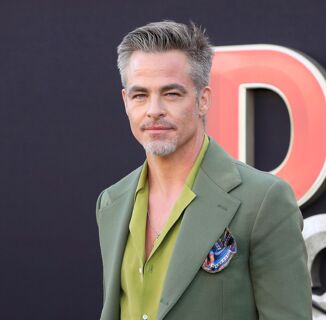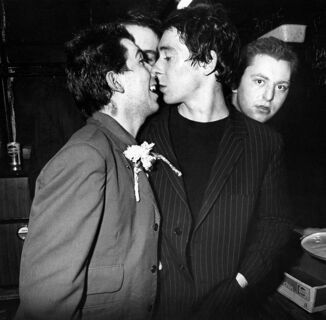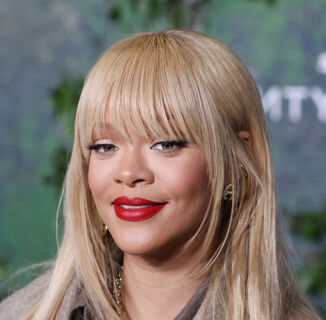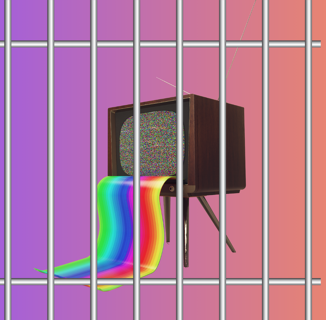Ty Defoe shares the stage nightly with Kate Bornstein in Straight White Men on Broadway. Originally from northern Wisconsin, the performer is a member of the Oneida and Ojibwe nations, of the Eagle Clan, and a descendant of Chief Buffalo, who also identifies as two-spirit.
Defoe also writes musical theater with long-time collaborator Tidtaya Sinutoke, with whom he wrote Clouds Are Pillows for the Moon, a musical about an Ojibwe girl and a Thai girl as they meet and pass through the rites of passage to womanhood together. The team won a Jonathan Larson Grant in 2017 for their work, and Defoe also holds a Grammy Award for his vocal work on Come to Me Great Mystery: Native American Healing Songs.

INTO spoke to Defoe on his many roles, on stage and off.
You do so many things! What ties everything together?
I think where I plant my roots in everything is the storytelling. I’m definitely a storyteller, and that’s one thing that I lead with. When I think about Westernized art and colonized art, the narrative for me is extremely important.
How did you find your way into storytelling in the theater?
Back home, I didn’t even know really what theater was, exactly, until a group of summer stock hippies came close to our reservation and they started doing theater, and I think it was a naked version of like Gypsy or something. And I thought it was just very strange, because I was like, “Wow, what are these naked hippies doing singing and dancing in the woods? That’s just very weird.”
So then I went back and I talked to some of my relatives and my uncle, who traveled back and forth from the city to where I grew up. And they were like, “Oh, that’s called theater. They’re doing a musical, or they’re doing a play.” And so I was like, “Oh. Well, what does that mean?” And they were like, “Well, you kind of tell these different truths from people’s perspectives in a sort of nuanced, sort of theatrical way,” and that’s how I was thinking about it.
Until I started working with other people and coming to larger cities, I wasn’t really sure that there was ever a space for someone like me to make story and create story, but it was just really on the trust and amazing teachers and mentors that I have had that said, “Well, Ty, you are a storyteller. Here are some formulas and tools to help you.”
What’s your relationship to space now?
In terms of space, I’m thinking about design. And sometimes, those designs in rooms aren’t meant for someone that looks like me, that talks like me, that tells stories like me, that sings songs likes me, that even has speech patterns like me. And oftentimes I think I’m meant to feel, and others are meant to feel, that there isn’t room, when in fact, with a lot of the equity work that I’m doing in the arts, the narrative [becomes] a tool to sort of open up those things that have been colonized.
So I look at those spaces that seem intangible as spaces that have been colonized: What are the ways in which folks who aren’t me, but are my allies, are decolonizing those spaces? And then, when I think about being there, I’m like, Well, what are the ways in which I can work in tandem? And one of the ways is indigenizing spaces — often, I think, sometimes referring to [what people call] a “safe space,” but I call it a brave space. These are spaces where you can be radically and fully your entire being and your entire self to express who you are.
Tell me about the hoop dance.
Well, when I was quite young, I was gifted a hoop. And that object then became somewhat special and sacred to me in terms of what I was going to do, because, like I said, I didn’t grow up in the middle of New York City or anything, where there is just so much in abundance of things, yet there was an abundance of nature, an abundance of culture, an abundance of time and space and processing.
So what I ended up doing with that hoop was figuring out ways that I can connect to the world, so to speak, through dance. And that dance is known as the hoop dance, and the hoop dance is very special from nation to nation. But to me, in terms of figuring out who I was at the time, it became a dance of radical acceptance, I think. It also became a dance of shapeshifting. The dancing and the dancer, it comes out of story: That the dance, like the metamorphosis, shapeshifts in and out and weaves in and out of the hoop, making different animal formations and things in nature.
It’s also decentralizing human beings, as two-legged beings, that everything is interconnected — not just based on race and sexual orientation and age and class and socioeconomic background, that kind of thing; we’re also looking at seeing [that] the two-legged, the four-legged, the winged, the things that are in the sky, from small insects to blades of grass — all these things are living entities. And the philosophy is, in the dance, that we should aspire to being harmonious.
But obviously, there are times in life — it’s a dance of life, a dance of teaching, of lifelong learning — that sometimes, these hoops these can be chaotic; sometimes they can fall to the ground.
But as the dance is going, as a form of prayer in motion (or sort of like a poem in motion), it tells us about our lifetime and what’s happening: To have perseverance and have resistance, to keep going. When you might think that there isn’t hope left, when you think there isn’t any inspiration, hopefully the hope is invoked by the dance and the dancer and the telling of the story. And also getting people to interact and get them to have the hoop so that they can dance together as well.
What does it mean for you to identify as two-spirit?
Now, two-spirit is interesting. I think it’s the closest thing, because English is so colonized. Every nation, I think, has a way of [referring to] the gender spectrum or gender fluidity — each nation and tribe that [existed] pre-English here in the United States or Turtle Island, and in other cultures as well around the world.
[Gender is] neither a line from very masculine to very feminine, it’s not vertical or horizontal — it’s expansive. And the best word, when people ask me about it for me to describe two-spirit is: It’s transcending what we know the construct of gender to be in society today.
What’s it like working with Kate Bornstein?
Oh my gosh. It’s a dream, it’s like a dream come true. Kate, in the queer community, has been visibly leading the charge for quite many many many decades. [chuckles] It’s funny. We have so many amazing conversations, and she’s kind of like the queer fairy goddess grandmother or something, [laughs] you know; and the way that she has moved in circles; and, of course, is like the most generous, giving, open-hearted person who had been on the front lines making space for people who are queer-identified for some time; and also pays tribute to those people who have worked alongside her, who have not been seen as well and documented as well as she has.
So she has just been a huge, fine example. She has so many great things to say about being trans, being herself — at some points a “tranny,” at other points being nonbinary, at some points identifying as “he,” and those have been such great, nuanced conversations. I feel almost like [chuckles] I get the privilege of having these oral stories being told to me as we’re just sitting and hanging out, having lunch together.
It also is a huge reminder and makes me feel quite comfortable, because of the way I grew up — talking to my elders, actually, and that lineage being preserved in archives, through just listening, and the giving and receiving of that. So it’s been a dream come true.

We seem to have a cultural tendency to want to limit intersectionality to a sort of monolithic application of identity, rather than tapping into the sophisticated tapestry of difference it offers. How do you interact with that tendency?
You know, that’s so important, and thanks for mentioning that. The art we’re making has to have resonance, but it also has the reflection of the world and society that’s around us. You can’t make pieces in a vacuum.
People are holding onto this word (“identity”), which is really somewhat challenging when you take a piece like Clouds Are Pillows for the Moon, for instance. There are two very rich (Ojibwe and Thai) identities coming together. And so when you think about, Where is the support for Clouds Are Pillows for the Moon? people are like, “You should get support from the Native, Indigenous community.” But when we go there, we’re often told, “Well, you have Asian people in your piece,” and I’m like, “Yeah, we do, actually.” And then some people say, “You should get support from the Asian community.” And we go to the Asian community and they’re like, “Well, you have Indigenous people in your piece.” I’m like, “Yes, we do.” So it’s like, well, what does that mean, then, for this piece?
We’re so limited to English for communicating. Obviously, people speak other languages, but somehow English becomes centralized to the way we categorize things. And that’s why I think it’s fascinating, being a word-carver, is that you have the options and ways to figure out how to shapeshift in and out of communities, to shapeshift in and out of words, to shapeshift in and out of conversations when you’re talking about work.
Given that so much of the power of colonization has to do with the use of language, what is the work that needs to be done around language?
We live in a created culture of transactional relationships, where it’s like, you only take the time out to get something from someone else, versus just sitting down and having a conversation of sharing. And oftentimes, it’s because that takes time, and time equals money, and money equals power.
So I think the way to assist and help that is to form strong relationships in people in your circle of friends, in your artmaking; to constantly vet things you’re doing as an individual, but also the art that you’re making, so that it could live in a type of truth; to be open to that.
Language definitely is living, and it has to shift and change. Even a couple of years ago, people who didn’t know too much about nonbinary weren’t using the word “they.” As you know, in journalism, there was a huge pushback against using that because of what we are taught from grammar school or Strunk & White, that it was defying how people were writing about trans folks and nonbinary folks… now you see “they” accepted in more places. It’s slow to change, but it is possible.
What I’ve learned from Kate Bornstein is the idea is to have empathy, because when you think about queer people and people color, all you need is one more time someone misgendering someone after they say their pronouns or something… it’s really hard. So it’s also to our own communities to find empathy and compassion.
And when patience has run out, how are we also holding each other and growing each other? That’s just so, so challenging and difficult. And to people that don’t identify how one does, how are those folks activating themselves to be the radical citizens of the world that we need them to be? How are we creating those spaces? It’s a complicated topic, obviously, but just to continually to remain engaged in conversation and dialogue.
Given that the TGNC community is populated by less visible folks, who for whatever reason don’t want to or are unable to come out, what do you see as your role in terms of creating space for those folks?
I feel like I’m constantly coming out, just based on how society is dictated by visualization and clocking people. For me, it’s not new to continually come out, either, because I’m also Native or Indigenous, and that’s a thing, an erasure that the United States definitely has. I still get people shaking my hand, saying I’m the first Native person that they’ve touched or seen or been near, and I’m like, “I don’t think so.” But, you know, that’s some people’s reality.
I think coming out as trans or nonbinary varies day-to-day, and I feel like I’m constantly evaluating the privileges that I have. Like, there are days where I feel like I pass more, and it’s safe for me to come out and to be outspoken about things. And then there are days where it’s just horrifying, based on the location and where I am. Like, it’s different when you get on a tiny plane in the middle of Michigan than in New York City. Often people [are] confused because I have long hair, and I like my hair long, because it’s also part of my culture.
So what are the ways in which I am constantly being an act of resistance for other people that might not have the strength in those moments to speak out for themselves? I’m thinking about those people constantly, regardless if they come out or not.
Some people just aren’t ready, because it’s a lot of personal undoing of self to have those conversations about who you are and how you’re seen in the world. So mostly, I try to lead with compassion for all people, because sometimes our inner selves are buried so deep within there that there’s so many things like internalized oppression, there are things in society that tell us it’s wrong… So everyone’s at different levels constantly, myself included. But what I try to focus on is to find liberation.
And what is liberation?
Liberation, to me, is: in instances, I’m strong enough to speak out about certain subjects; I have gathered groups of people through doing social justice work where I have a nice group of people to help support me; and speaking my truth to power; to being transparent in rooms where people are feeling something and they’re unable to speak it; to enter conversations in that way to people who are afraid to even talk about language around trans or nonconforming people; to sit down and have conversations with those people; to have patience, where my brother or sister or cousin or friend might not, in that moment, be able to do that. Those are just some small things I feel like I can contribute.
Straight White Men plays at The Hayes Theater, 240 West 44th Street, through Sunday, September 9. See 2st.com for details.
This interview has been condensed.
Images via Getty
Help make sure LGBTQ+ stories are being told...
We can't rely on mainstream media to tell our stories. That's why we don't lock our articles behind a paywall. Will you support our mission with a contribution today?
Cancel anytime · Proudly LGBTQ+ owned and operated
Read More in Culture
The Latest on INTO
Subscribe to get a twice-weekly dose of queer news, updates, and insights from the INTO team.
in Your Inbox














